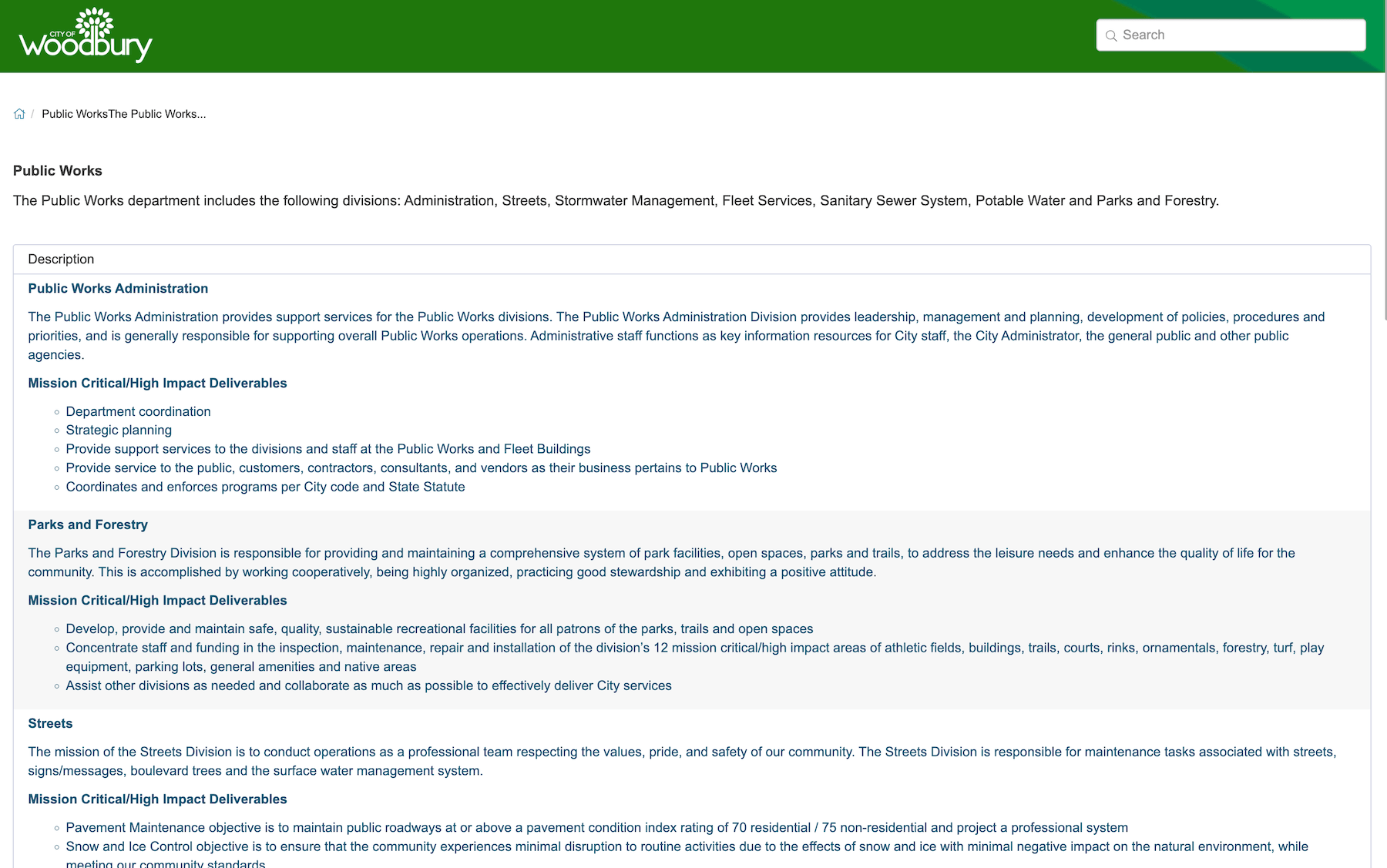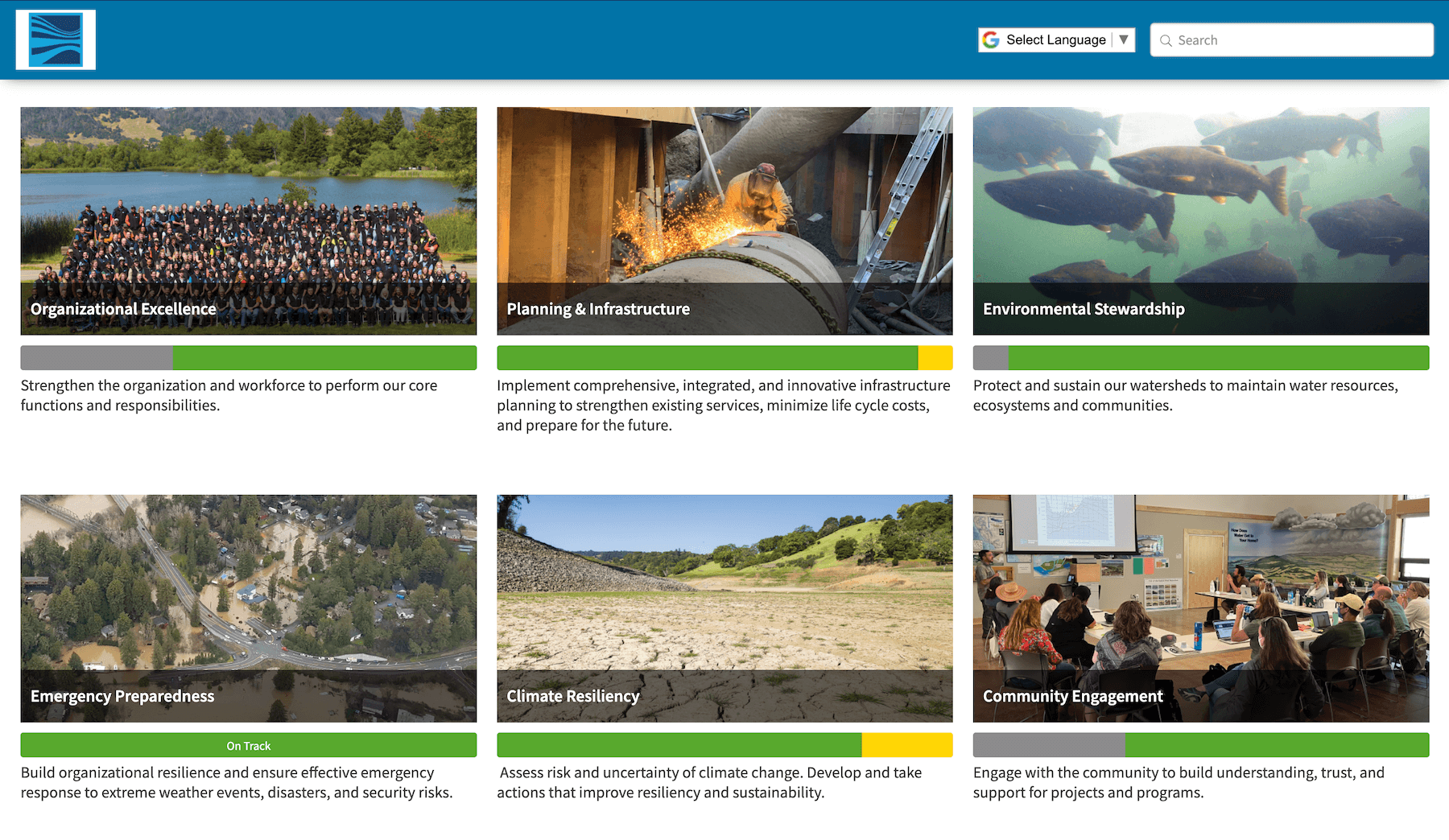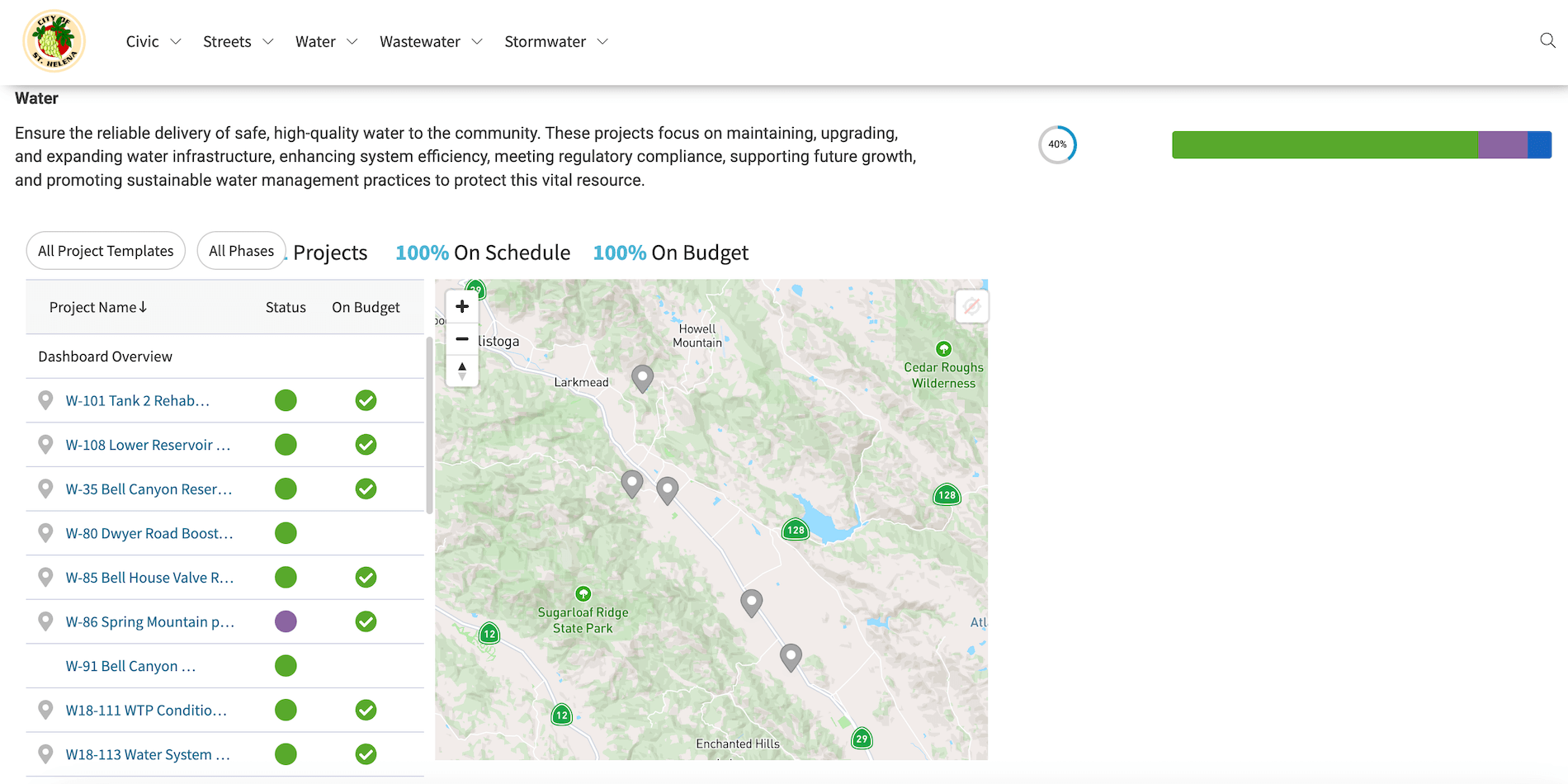Contents
Public works departments are the behind-the-scenes heroes of a smooth-running community. We can thank them for everything … from street maintenance to stormwater systems to emergency snow clearing at 3 a.m. Their mandate is vast, complex, and vital to community wellbeing. With aging infrastructure, tight budgets, climate impacts, and other concerns, strategic planning in public works requires both ambition and organization.
A well-executed public works strategic plan is essential for any local government department maintaining critical infrastructure, managing assets, and keeping communities safe.
Based on insights from experts and municipalities across Canada and the U.S., here are four best practices for developing or refreshing your plan.
1. Embrace the complexity, and plan for it
Public works projects often involve complex, multi-stage processes—like road reconstruction—that require holistic planning and coordination. For instance, Canadian municipalities spend billions on infrastructure annually, yet it never seems enough to address all the needs of a community. It can feel a bit like a Sisyphian task…Departments juggle competing demands: maintaining aging infrastructure while meeting growing needs for roads, transit, and utilities—within environmental and social constraints.
And there’s always more to do.
Rather than shy away from this complexity, embrace it with a holistic strategic approach. This means acknowledging that all your assets and services are interconnected and planning for the long term, not just reacting to one crisis after another.
Start with strong leadership and integrated strategy.
APWA (American Public Works Association) encourages public works leaders to “plan for the future” by using strategic planning based on a shared vision for their organizations. Public works leaders must foster a culture ready to innovate and improve continuously.
A clear vision, co-created with your team and community, acts as a North Star when juggling competing priorities. It helps ensure that whether you’re dealing with road maintenance or water treatment upgrades, all efforts ladder up to a common purpose. In practice, this could involve training staff in asset management principles, or adopting a continuous improvement mindset so that your organization stays adaptable.
Bottom line: Embracing the level of complexity required in public works plans often requires change management skills in leadership.
Use a systems approach.
Don’t plan infrastructure in isolation. Silos and poor links between plans derail efficient spending. Tie everything together.
The Federation of Canadian Municipalities recommends integrated planning: a capital infrastructure plan that aligns with your land-use plan, financial plan, and overall development plan. By integrating these, you ensure that growth patterns, infrastructure investments, and budgeting all inform each other.
For instance, if your community envisions a new transit-oriented development, your public works strategic plan should anticipate the necessary road upgrades, water/sewer expansion, and maintenance funding to support it.
Bottom line: Embracing complexity means viewing your infrastructure as an interdependent system and planning accordingly.
Balance competing priorities with data and foresight.
Complex doesn’t have to mean chaos Leverage data (see Best Practice #3) to weigh priorities. Strategic planning software, asset inventories, and risk assessments help you see the big picture.
For example, use a risk matrix to compare a bridge replacement versus a water treatment upgrade by safety risk, service impact, and cost—helping you decide what comes first. Translating technical issues into clear consequences (e.g. “if we don’t replace this pipe now, it’ll cost 5x more after it fails”) enables informed decisions.
Embracing complexity gets easier when everyone understands what’s at stake.
Bottom line: A robust public works strategic plan should acknowledge the complexity up front, set a unifying vision, and use integrated, data-informed strategies to manage that complexity proactively.
Real-world example: Woodbury, Minnesota
The City of Woodbury is a great example of coordinated complexity in action. Its Public Works Department includes eight integrated divisions: Administration, Streets, Stormwater Management, Fleet Services, Sanitary Sewer, Potable Water, and Parks and Forestry.
Each division is guided by mission-critical deliverables that align to broader strategic goals:
- Administration provides department-wide coordination, leadership, and policy development.
- Parks and Forestry maintains recreational infrastructure through inspection, maintenance, and collaboration.
- Streets oversees pavement, snow and ice control, and signage—grounded in metrics and regulatory compliance.
- Stormwater Management ensures runoff control and NPDES permit compliance alongside Engineering.
- Fleet Services maintains vehicles and equipment for all divisions, ensuring emergency readiness.
- Water and Sewer Divisions deliver safe, reliable service, including wellhead protection and system maintenance.
By treating each division as both autonomous and interdependent, Woodbury operationalizes the APWA concept of systems thinking and cross-functional planning. Their strategic use of Envisio dashboards further enables data-backed oversight across all functions.
Takeaway tip: Your public works strategic plan should not flatten complexity, it should structure it. Outline goals for each division and connect them through shared objectives and performance metrics. The result? A strategy that drives impact.
2. Prioritize community engagement and transparency
The best public works strategic plan is built with the community. That means inviting feedback, and communicating transparently. After all, the public is both your customer and your funder.
That makes community engagement and transparency strategic necessities. When residents, businesses, and elected officials are engaged early and openly, you build the trust and buy-in needed to carry out your plan successfully.
Engage relevant parties early and often.
Don’t wait until finalizing your strategic plan to consult the community; involve them at the visioning stage and at key decision points! The public should be seen as a primary party in infrastructure decision-making. Mechanisms like public polls, surveys, open houses, focus groups, and advisory committees are great ways to gather input.
Bottom line: When people understand why a project is needed and have had a chance to voice their opinions, they are far more likely to support it.
Being transparent helps build trust.
Engagement and transparency go hand in hand. APWA’s Leadership and Management Committee puts it well:
Public works leaders must “create a culture of openness, democracy, transparency, and public-mindedness,” because only through ethical, transparent leadership can we sustain the public’s trust in our decisions and stewardship of resources.
In practical terms, this means sharing information proactively—the good and the bad. Don’t just highlight successes; also communicate challenges and how you’ll address them. If a project is delayed or over-budget, explain why. Use multiple channels—council meetings, newsletters, social media, dashboards—to report real-time progress on strategic initiatives.
Consider forming a citizen advisory committee or hosting regular town halls during implementation. Define and share service level targets (e.g. snow clearing within X hours, asset conditions) and report results. When the community sees clear goals and transparent progress—even if targets aren’t fully met—it builds trust and credibility.
Bottom line: In the long run, community trust makes it so much easier to secure public and political support for tough decisions, whether it’s budget allocations for a major repair project, or disruptive construction projects.
Leverage ethical leadership.
Prioritizing engagement means leading in a way that values people. Ensure you’re hearing from a diverse cross-section of your community, not just the loudest voices.
This could mean offering materials in multiple languages, going out to meet people where they are (community centers, cultural events), or using online tools to reach younger demographics. When people feel heard and respected in the planning process, they are more likely to champion your public works strategic plan.
Bottom line: A strategic plan built with the community, not just for the community, stands the best chance of long-term success.
Real-world example: Sonoma County Water Agency, California
The Sonoma County Water Agency (Sonoma Water) is leading by example with a five-year strategic plan that places community engagement and transparency at its core. Their publicly accessible performance dashboard breaks down the agency’s strategic goals into measurable actions—providing real-time updates on progress and highlighting any disruptions or risks.
Each goal—from infrastructure resilience to climate adaptation and emergency preparedness—is paired with detailed metrics and current status updates.
For instance, 86.4% of their projects are currently “on track,” and every strategy is tied to a clearly defined progress percentage. Visual status indicators offer immediate clarity on performance, making the plan not only strategic but also publicly accountable.
But what truly sets Sonoma Water apart is the depth of their community engagement programming:
- The district has hosted thousands of students through classroom visits and education center tours, reaching over 7,500 students across all grade levels during the current school year alone.
- They maintain inclusive communications practices, ensuring materials are available in multiple languages and tailored to underserved populations.
- They build and deepen partnerships with organizations like the Russian River Watershed Association and Sonoma Clean Power, extending education and infrastructure awareness beyond their core water supply service area.
- Their engagement work is ongoing, with clear accountability built into their dashboard under the “Community Engagement” goal—tracking not only progress but impact.
By combining education, transparency, and partnerships, Sonoma Water is building long-term community trust and support for the complex work of infrastructure planning and delivery.
Takeaway tip: Follow Sonoma Water’s lead by engraining transparency and inclusive engagement directly into your public works strategic plan. Use public dashboards to show your public works plan’s progress, and create clear avenues for residents to learn, participate, and weigh in on decisions that shape their communities.
3. Leverage technology to streamline and measure progress
Managing a public works strategic plan using paper forms or Excel spreadsheets might feel familiar, but it ultimately makes it harder to stay responsive and efficient. Adopting public sector specific software can help public works teams measure and track activity in real-time.
The most helpful kind of tool when faced with complex, multifaceted goals is a centralized online hub to support performance measurement. Knowing what to measure, and having the systems in place to measure it, helps to manage performance and turn goals into outcomes.
Measure performance and report it.
A strategic plan isn’t complete without metrics to gauge success. Whether your goals are to improve road conditions, reduce facility energy use, or enhance customer service, it’s important to identify key performance indicators (KPIs) and use technology to track them.
Consider implementing a dashboard that aggregates your KPIs in one place.
Some examples of performance measures for public works include measuring water loss, water usage, or the amount of recycling being collected. Leveraging a public-sector performance management tool (like Envisio’s own analytics and dashboard software) designed for this purpose allows you to align performance measures with strategic goals and update progress easily.
For example, the City of Ontario, California uses a centralized performance management platform to track the progress of its capital projects and strategic initiatives, enabling staff to update budgets and timelines and share those updates with leadership and the community in real time.
Bottom line: What gets measured has a better chance of getting done on time, and on budget. Measuring progress means cultivating an atmosphere of measuring performance.
Real-world example: City of St. Helena, California
The City of St. Helena demonstrates how to use technology to manage a capital-intensive public works program with clarity and control. Through their Envisio-powered Capital Improvement Program (CIP) dashboard, St. Helena shares progress on a five-year, $66.2 million investment portfolio encompassing a whopping 106 public works projects.
Each project is categorized under a strategic goal—such as Transportation, Water, or Public Facilities—and includes key data points like budget, expenditures, progress percentage, and project phase (e.g., early design, final design, or close-out). Visitors can instantly see, for example, that:
- 100% of Sulphur Creek Erosion Repair and Grayson/South Crane Rehab projects are completed or on track.
- Sidewalk, traffic calming, and ADA accessibility projects are progressing in phases, with timelines and expenditures transparently reported.
The city identifies projects with “Major Disruption” or “Future Fiscal Year” status, setting expectations clearly.
This level of detail turns the strategic plan from a static PDF into a living, measurable program. Folks can follow progress in real-time and understand how each project supports goals such as sustainability, accessibility, and safety.
Takeaway tip: Follow St. Helena’s lead—use digital dashboards and performance systems to monitor and refine your strategy. When the public and council can see clear progress—complete with timelines, spending, and status—you build trust and improve internal coordination.
4. Align strategy with budget
Ensure your public works strategic plan aligns with your city’s overall financial strategy. If there’s a long-range financial or debt management plan, factor it in.
A strategic plan shouldn’t be static—it must flex with new opportunities or constraints. We call this a “living plan”.
Having a plan that is living and agile is critically important during times of rapid change. Update the plan regularly to reflect current conditions and maintain credibility.
In times of financial uncertainty, aligning strategy with funding ensures your plan is realistic. You might take a priority-based budgeting approach to clarify where resources are most needed, and link each project directly to your budget process.
Connect your public works plan to your budget and capital plan.
Your public works strategic plan and your budget should be two sides of the same coin. Each goal or initiative should correspond to a line in your capital improvement or operating budget. When plans aren’t linked to finances, departments may pursue unaligned projects or leave key goals or programs underfunded.
Use your strategic plan to drive evidence-based budget discussions. For instance, if the plan targets water quality compliance, the utilities department should have a funded project to upgrade systems. Many cities score potential projects against strategic goals, and fund those with the highest alignment.
Aligning with funding realities often means smart prioritization—doing the most important things with limited dollars. Develop criteria to rank projects, such as urgency (e.g. safety or regulatory requirements), community impact, economic return, and feasibility.
Scoring projects with these criteria helps create a phased plan that fits your budget. FCM recommends formal prioritization models—like weighted scoring or business-case approaches—to link capital planning with operations and maintenance.
And of course… Don’t build what you can’t maintain! If you add a new facility, ensure future operating budgets cover staffing and upkeep. Taking a life-cycle view of costs makes your strategic plan financially sustainable.
Bottom line: Use your strategic plan to help drive evidence-based budget discussions and decisions.
Explore diverse funding sources.
Sometimes, funding realities can be improved. This could involve pursuing federal or state-level infrastructure grants, taxation increases, or regional cost-sharing agreements.
Part of clarity in a public works strategic plan is a candid assessment of the infrastructure gap and a plan to close it: If decision-makers know, “To maintain our roads at a reasonable level, we need to invest $X million per year,” it creates a reference point for budget deliberations and helps justify budget increases or grant requests.
Bottom line: Whether it’s through reallocated internal budgets, trimming programs, or advocating for new revenue, make sure your strategic plan has a diverse funding section.
Real-world example: City of Ontario, California
A great example comes from the City of Ontario, California, which confronted a large list of major changing infrastructure needs. Rather than scaling back its strategic goals, Ontario’s leadership got creative: they went to their community with a ballot measure (Measure Q) to raise the sales tax by 1%. By clearly communicating the needs and the specific projects this tax would fund (improved drinking water systems, better flood control, citywide fiber internet), they earned public approval for the measure.
“Ontario is really leading the way by allowing people like Jordan and I to be creative and explore new softwares like Envisio. We’ve been able to move forward with so many initiatives, partly due to a new sales tax measure that we just initiated called Measure Q.”
– Ria Pavia, the Deputy Director of Innovation, Performance, and Audit at the City of Ontario.
Measure Q is now generating an estimated $95 million in new revenue dedicated to the city’s capital plans.
Takeaway tip: Even the most forward-thinking strategic plan must grapple with a hard truth: funding constraints. A public works strategic plan will only be as successful as the financial strategy behind it. It’s critical to align your goals and projects with the fiscal reality of your municipality, and to be creative in securing resources.
So, in conclusion, the 4 best practices for developing your public works strategic plan are:
- Embracing complexity
- Engaging the community
- Leveraging technology and data
- Grounding your strategy in financial realities
These practices are interconnected. Transparent engagement can lead to better funding outcomes, and data can support smarter investment decisions.
As you refine your plan, ask: Can we measure performance effectively? Are our objectives linked to funding?
Strategic planning is not a one-time event—it’s a continuous process. Create a living plan where you monitor, report, and adapt regularly. Celebrate your wins and learn from what didn’t go as planned.
And don’t go it alone! Other municipalities—like Woodbury, Sonoma, and St. Helena—are leading the way. Sharing what works helps everyone drive better community outcomes faster and with less waste.
Request a demo ↓
Ready to move from planning to progress? Envisio has helped over 200 municipalities turn strategy into action with tools for performance tracking, dashboards, and alignment. Request a free demo to see how we can support your public works strategic planning journey.








